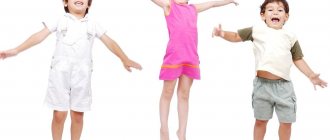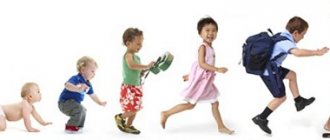A child’s communication and attitude towards other people changes significantly during preschool age. Thus, in the middle of preschool age (4-5 years), the need for recognition and respect appears and begins to dominate. If until the age of 3-4 years children received direct pleasure from playing with toys, now it is important for them to know how their actions are perceived and evaluated by the people around them. The child strives to attract the attention of others, sensitively catches signs of attitude toward himself in their glances and facial expressions, and demonstrates resentment in response to inattention or reproaches from partners. In children's communication at this age, a competitive, competitive element appears. The peer becomes the subject of constant comparison with oneself. Through such a comparison of his specific qualities, skills and abilities, the child can evaluate and affirm himself as the owner of certain advantages.
This stage is natural and necessary for the development of interpersonal relationships. By contrasting himself with a peer and thus highlighting his “I,” the child can return to his peer and perceive him as an integral, valuable person. Usually by the age of 6-7 years, the ability to appreciate the qualities and skills of other people, the desire to be friends, help, and do something together appears.
However, demonstrativeness is often fixed and develops into a personal characteristic, a stable character trait. Such children are most concerned with showing their superiority in everything. The main motive for the child’s actions is the positive assessment of others, with the help of which he satisfies his own exaggerated need for self-affirmation.
Peculiarities of behavior of demonstrative children
Unlike touchy and shy children, demonstrative children are distinguished by their pronounced activity and desire to attract attention by any possible means . Such children, as a rule, are quite active in communication. However, in most cases, when turning to a partner, they do not feel real interest in him or desire to do something together. Mostly they want to show themselves and arouse the admiration of others: they talk about themselves, show off their toys, demonstrate any means of attracting the attention of adults or peers. “Look how I can draw, jump, how quickly I eat, what kind of slippers I have, etc.” Self-affirmation and the admiring attention of others are their main goal and value. At the same time, both positive forms of behavior (“look how good I am”) and actions expressing aggression can be a way of attracting attention. Demonstrative children are very focused on the assessment of others , especially adults. As a rule, such children strive at all costs to obtain a positive assessment of themselves and their actions. However, in cases where relationships with adults or peers do not work out, demonstrative children use negative behavioral tactics: they show aggression, complain, provoke scandals and quarrels.
Demonstrativeness can manifest itself not only in the desire to show one’s own merits and achievements. Possessing attractive objects is also a traditional form of self-display. For many children, the strong desire to own some kind of car or doll is not connected with their own gaming needs, but with the desire to demonstrate their property (and therefore an advantage) over others. How often, having received a new toy as a gift, children take it to kindergarten not to play with it, but to show it off and show it off.
Self-affirmation is often achieved by reducing the value or devaluing of another . For example, after seeing a drawing by a peer, a demonstrative child may say: “I draw better, this is not a beautiful drawing at all.” In general, comparative forms prevail in the speech of demonstrative children: better/worse; prettier/uglier, etc. They constantly compare themselves with others, and it is clear that this comparison is always “in their favor.”
Demonstrative children show increased interest in the actions of their peers: they watch what others are doing, make comments and comments, while their interest is clearly evaluative. So, Nastya D. (5 years 9 months), as soon as the adult gave the task to her partner, she began to be loudly indignant: “Why did they tell Nikita to do it, he doesn’t know how to do anything, and in his quiet time he behaved badly. The teacher scolded him. I’ll do better, can I, well, please.” At the same time, she continuously watched Nikita’s actions and tried to insert elements into his mosaic herself.
In addition, the behavior of demonstrative children is characterized by high normativity: children often explain the motivation for the action by saying that it is necessary. Using socially approved forms of behavior, children constantly expect and demand positive evaluation of their actions. However, their correct moral actions are unstable and dependent on the situation. Demonstrative children can solve the same problem in different ways, depending on the presence or absence of an adult. For example, in one of our studies, a situation was organized in which the child could share or not share candy with his partner. In the first situation, an adult was present in the room, although he did not take part in what was happening. Demonstrative children shared with a peer, commenting on their action out loud, turning to an adult. For example, Lyusya D. (5 years 7 months), looking at an adult, says: “I’ll give Katya candy, because she didn’t get any. Good children always share with those who were not given. Really, did I do a good job?...” In the second situation, the adult left the room, but all the children’s words were recorded on a voice recorder. This time, the same children did not even think about sharing with their partner, even despite their requests. The same Lucy D., in response to a peer’s request to give him half a candy, this time said: “I won’t give it to you. Why should I? This was given to me. Ask, maybe they will give it to you.” Thus, there is a pronounced formalism . For them, it is much more important to comply with the external picture of approved behavior than to actually help a peer. Thus, even when performing a kind deed, a child does it not for the sake of another, but in order to demonstrate his own kindness to others (a certain form of “ostentatious altruism”).
Demonstrative children react very emotionally and even painfully to the reproach and praise of other children. When an adult gives a negative assessment to the actions of a peer, a demonstrative child enthusiastically and with great pleasure supports her. In response to the praise of a peer, he, on the contrary, begins to object. Thus, Anya R. (6 years 1 month), after listening to praise addressed to a peer, said: “Well, maybe it’s better than last time, but it’s still ugly and uneven.”
Demonstrativeness is very clearly revealed in the nature and degree of help to other children. So, in one of the classes, we asked two children to assemble their own pattern from a mosaic - the sun in the sky, while the parts of different colors were not distributed equally: one child had predominantly yellow parts, the other - blue. Accordingly, in order to complete the task, the child is forced to turn to a peer for help and ask for the necessary details. Observations showed that the majority of demonstrative children in this situation provided formal provocative assistance, i.e. in response to a peer’s request, they gave only one element, which was clearly not enough. Thus, Mitya S. (5 years 11 months) noticed that his partner did not have the necessary yellow elements, but he sat silently and did not ask him for anything. Then Mitya turned to his partner with the words: “Sasha, if you don’t ask for permission, I won’t give it to you.” Sasha continued to sit silently, Mitya repeated: “Ask, and I’ll give.” Sasha asked very quietly: “Give me a few yellow ones, otherwise I didn’t have enough.” Mitya smiled and put one element in Sasha’s box with the words: “Here, you asked, I gave it.” To Sasha’s further requests, Mitya answered irritably: “I already gave it to you.” Don’t you see, I do the same, wait.” Igor B. (5 years 8 months), in response to a peer’s request, began to give him elements of any colors except the one that was actually needed, while he pretended that he did not hear his peer’s objections at all. Other children began to share as soon as they finished their mosaic, but they did it very reluctantly. This type of assistance, without harming oneself, can be called pragmatic. Thus, Roma S. (5 years 2 months) did not react in any way to his partner’s requests for the necessary elements, pretended that he did not hear, and sang a song loudly. As soon as he completed his picture, he looked at his partner with interest: “Oh, you don’t have any yellow ones. You’ll have to add a little extra... Don’t be afraid, we’ll give it to you.” Having put several yellow elements in the box for his partner, Roma turned to the adult: “Look how much I gave him.”
From these examples it is clear that the basis of these children’s attitude towards others is the desire to surpass others, to show their advantages. This is manifested in the constant comparison of one’s achievements with the successes of others, in demonstrating one’s superiority in everything.
For demonstrative children, another child acts mainly as a bearer of a certain attitude; he is interesting only in connection with the attitude he shows towards him - whether he appreciates or does not appreciate, helps or not. For example, Nastya talks about her friend Katya like this: “Katya helps me, if I get into trouble, she is friends with me, she can help me with drawing. Kind because she plays with me. Of course, I am also kind. I’m just like Katya, even I’m even better.”
Sources
- Duarte Armindo R., Pinto J., Pereira C., Vasconcelos M., Palavra F. Unilateral Optic Neuritis in Children: Experience of a Tertiary Center. // Eur Neurol - 2021 - Vol83 - N3 - p.251-258; PMID:32570233
- Al-Qattan MM. A Review of the Phenotype of Synpolydactyly Type 1 in Homozygous Patients: Defining the Relatively Long and Medially Deviated Big Toe with/without Cupping of the Forefoot as a Pathognomonic Feature in the Phenotype. // Biomed Res Int - 2021 - Vol2020 - NNULL - p.2067186; PMID:32509852
- Onay ÖS., Sağlık AÇ., Köşger P., Saraçoğlu ZN., Toprak U., Uçar B., Tekin AN. Maternal and fetal tuberous sclerosis complex: a case report questioning clinical approach. // Turk J Pediatr - 2021 - Vol62 - N2 - p.332-337; PMID:32419429
- King RA., Scott KE., Renno MP., Shutts K. Counterstereotyping can change children's thinking about boys' and girls' toy preferences. // J Exp Child Psychol - 2021 - Vol191 - NNULL - p.104753; PMID:31841820
- Sigfusdottir ID., Soriano HE., Mann MJ., Kristjansson AL. Prevention Is Possible: A Brief History of the Origin and Dissemination of the Icelandic Prevention Model. // Health Promot Pract - 2021 - Vol21 - N1 - p.58-61; PMID:31841374
- Turgut M., Akhaddar A., Turgut AT. Calcified or Ossified Chronic Subdural Hematoma: A Systematic Review of 114 Cases Reported During Last Century with a Demonstrative Case Report. // World Neurosurg - 2021 - Vol134 - NNULL - p.240-263; PMID:31682989
- Janicas RCSV., Narchi NZ. Evaluation of nursing students' learning using realistic scenarios with and without debriefing. // Rev Lat Am Enfermagem - 2021 - Vol27 - NNULL - p.e3187; PMID:31596419
- de Siqueira MFG., de Sousa ET., Alves VF., Sampaio FC., Diniz MB. Maternal report underestimates the amount of dentifrice used by children during toothbrushing: a cross-sectional study. // Eur Arch Paediatr Dent - 2021 - Vol20 - N6 - p.603-607; PMID:31087255
- Lee DJ., Yang W., Propst EJ., Rosenblatt SD., Hseu A., Wolter NE. Tracheo-innominate fistula in children: A systematic review of literature. // Laryngoscope - 2021 - Vol130 - N1 - p.217-224; PMID:30632162
- Li Y., Shen M., Long M. A preliminary study of auditory mismatch response on the day of cochlear implant activation in children with hearing aids prior implantation. // PLoS One - 2021 - Vol14 - N1 - p.e0210457; PMID:30615690
What underlies children's demonstrativeness?
So, ideas about the own qualities and abilities of demonstrative children need constant reinforcement through comparison with someone else, the bearer of which is a peer. These children have a pronounced need for other people; they constantly need company and communication. But other people are needed to show oneself, to have something to compare with. When comparing oneself with another, a pronounced competitiveness and a strong orientation towards the assessment of others .
One of the ways of self-affirmation is compliance with moral standards, which is aimed at receiving encouragement from adults or at feeling one’s own moral superiority. Therefore, such children sometimes do good, noble deeds. However, adherence to moral norms is clearly formal and demonstrative; it is not aimed at other children, but at receiving a positive assessment, at establishing oneself in the eyes of others.
One’s own “kindness” or “fairness” is emphasized as personal advantages and is contrasted with other, “bad” children.
Unlike other problematic forms of interpersonal relationships (such as aggressiveness or shyness), demonstrativeness is not considered a negative and, in fact, problematic quality. Moreover, at present, some features inherent in demonstrative children, on the contrary, are socially approved: perseverance, healthy egoism, the ability to achieve one’s own, the desire for recognition, ambition are considered the key to a successful life position. However, this does not take into account that opposing oneself to another, the painful need for recognition and self-affirmation are the shaky foundation of psychological comfort and certain actions. The insatiable need for praise and superiority over others becomes the main motive for all actions and deeds. The “I” of such a child is at the center of his world and consciousness; he constantly examines and evaluates himself through the eyes of others, perceives himself exclusively through the attitude of others, and this attitude must be enthusiastic. He is confident that others should think only of him, admire his virtues and express their admiration. Such a child is constantly afraid of being worse than others. This fear gives rise to anxiety, self-doubt, and constant tension, which is compensated by boasting and emphasizing one’s advantages. The main difficulty is not even that such a child incorrectly evaluates himself, but that this assessment becomes the main content of his life , covering up the entire world around him and other people. He literally sees nothing except what others think and say about him. Such tension can cause not only envy and jealousy when meeting a more successful peer, but also various neurotic deviations. That is why it is important to promptly identify manifestations of demonstrativeness as a personal quality and help the child overcome such a competitive position.
Withdrawal from activities
In some cases, the increased need for attention to oneself does not find immediate manifestations in behavior, since they are restrained by increased anxiety. With this combination of psychological characteristics, an internal conflict arises in the child: on the one hand, he wants to behave brightly, to be noticed by other people; on the other hand, due to high anxiety, he fears that such behavior will cause a negative reaction from others. This conflict is resolved through the development of defensive fantasy. Outwardly, the child remains passive, and his real life is spent in dreams. This type of behavior is called “withdrawal from activity.”
Is it possible to overcome the competitive position of a preschooler
Recently, the formation of positive self-esteem, encouragement and recognition of the child’s merits have become almost the main methods of social and moral education. This method is based on the belief that positive self-esteem provides emotional comfort to the child and promotes the development of self-confidence. Such upbringing really reinforces and strengthens positive self-esteem, the confidence that “I am better than everyone else.” As a result, the child begins to perceive and experience only himself and his attitude towards himself. And this, as shown above, is the main problem of demonstrative children. Such focus on oneself and one’s own merits does not allow one to see the other, turning him into a competitor and adversary. Therefore, the absence of evaluations and comparisons of children (who is better and who is worse) should be one of the first conditions for overcoming demonstrativeness.
Adults should strive to save the child from the need to assert himself and prove his superiority. A child, even without constant praise and evaluation, should feel respect for himself and the love of close adults. Only then will he feel the pricelessness of his personality and will not need constant encouragement and comparisons with others.
It is also necessary to abandon the competitive nature of games and activities. Competitions, competitive games, duels and competitions are very common and widely used in education. However, all these games direct the child’s attention to his own qualities and merits, generate an orientation towards the assessment of others and towards demonstrating his advantages.
To overcome demonstrativeness, the main thing is to show the child that the assessment and attitude of others is far from the most important thing in his life , and that other children are not at all focused on his person. They have their own interests, desires and problems, which are no worse or better, but simply different.
Of course, it is useless to explain all this in words to a preschooler. You can “move” a child away from such fixation on himself by opening him up to new interests, switching to cooperation and full-fledged communication . Traditional activities for preschoolers - drawing, modeling, design and, of course, playing - open up rich opportunities for this. A child should experience the pleasure of drawing or playing - not because he does it best and will be praised for it, but because it is interesting, especially if you do it all together. Interest in fairy tales, songs, and looking at pictures distracts the child from evaluating himself and thoughts about how others treat him. Other children should not become a source of resentment for him, but partners in a common cause. He must understand that other children do not exist to respect and praise him. They have their own interests and desires, which are not at all related to his person. To do this, it is important to create situations and organize games in which children can experience community and involvement with each other in real interaction. These are primarily role-playing games, round dance games, simple games with rules, etc.
Here are a few games that will help you better see your peers, appreciate them and experience a sense of community with them. From 2 to 6 children of senior preschool age (5-6 years old) can participate in these games.
Specifics of adolescence
Teenage children have their own characteristics. First of all, this is a marginal position (the transition from childhood to adulthood), the assimilation of new social roles, dependent or semi-dependent status, and the formation of values.
Among the characteristics of behavior and mentality:
- thirst for activity;
- ambition;
- a specific understanding of oneself and the world (contradictory and dual attitudes);
- interconnectedness, shared activity and group self-reflexivity;
- group consciousness;
- maximalism;
- demonstration of courage and originality;
- striving for the ideal;
- development of personal reflection;
- receptivity to any information and any volume of it;
- critical thinking;
- search for alternative options and your position;
- formation of subjective reality;
- plurality of social choices.
The leading activity of adolescence is interpersonal communication with peers. However, L.I. Feldshtein called socially useful activities the leading one. And communication with peers, according to the author, became the main thing when it was impossible to implement the first activity.
At this age, there is a conflict between the theory of a teenager (active value-creative activity) and the practice of the previous age (incomplete inclusion in society).
The instability and inconsistency of youth consciousness influence many forms of behavior and activity of the individual. Need I say that it is not easy to avoid deviations only against the background of natural age-related changes? All features of age can be called personal factors of deviant behavior. And if more negative external factors join in...
"Mirror"
Before the start of the game there is a warm-up. The adult stands in front of the children and asks them to repeat his movements as accurately as possible. He demonstrates light physical exercises and the children imitate his movements. After this, the children are divided into pairs and each pair takes turns “performing” in front of the others. In each pair, one performs some action (for example, clapping his hands or raising his arms, or leaning to the side), and the other tries to reproduce his movement as accurately as possible, as in a mirror. Each couple decides for itself who will show and who will reproduce the movements. If a mirror distorts or is late, it is damaged (or crooked). A couple of children are asked to practice and “fix” a damaged mirror.
When all the mirrors are working normally, the adult invites the children to do what people usually do in front of a mirror: wash, comb their hair, do exercises, dance. The mirror must simultaneously repeat all the person’s actions. You just need to try to do it very accurately, because there are no inaccurate mirrors!
Advertising
"Echo"
An adult tells the children about Echo, who lives in the mountains or in a large empty room; you cannot see it, but you can hear it: it repeats everything, even the strangest sounds. After this, the children are divided into two groups, one of which depicts travelers in the mountains, and the other - Echo. The first group of children in single file (in a chain) “travels around the room” and takes turns making different sounds (not words, but sound combinations), for example: “Au-u-u-u”, or: “Tr-r-r-r” , and so on. There should be long pauses between sounds, which are best regulated by the presenter. He can also monitor the order of pronounced sounds, i.e. show which of the children should make their sound and when. Children of the second group hide in different places in the room, listen carefully and try to reproduce as accurately as possible everything they heard. If Echo works asynchronously, i.e. does not reproduce sounds simultaneously, this is not scary. It is important that it does not distort sounds and reproduces them accurately.
"Magic glasses"
An adult solemnly announces that he has magic glasses through which one can see only the good that is in a person, even what a person sometimes hides from everyone. “Now I’m going to try on these glasses... Oh, how beautiful, funny, smart you all are!” Approaching each child, the adult names one of his virtues (someone draws well, someone has a new doll, someone makes their bed well). “Now let each of you try on glasses, look at others and try to see as much good as possible in everyone. Maybe even something I hadn’t noticed before.” Children take turns putting on magic glasses and naming the virtues of their comrades. If someone is at a loss, you can help him and suggest some virtue of his friend. Repetition is not a problem here, although if possible it is advisable to expand the range of good qualities.
Imaginary diseases
Often, in order to attract additional attention to themselves, demonstrative children “exploit” their existing illnesses (behave as if their illness is much more severe than it actually is) or even “create” illnesses for themselves. To do this, you just need to listen carefully to your body. “Does my head hurt? It seems not. What about the throat? Also no. What about your stomach? Oh, I think I'm a little nauseous! Internal organs “do not like” too close monitoring of their work. Such listening to oneself disrupts the normal automatic regulation of bodily processes - and indeed nausea, pain, and spasms may occur.
Excessive worries of others about the child’s well-being prompts him to increasingly resort to this method of attracting attention to himself. Then the same mechanism begins to be used for more practical purposes - for example, to evade an upcoming test for which the child is not sufficiently prepared.
"Bragging Competition"
An adult invites the children to hold a braggart competition. “The one who boasts the best wins. We will not brag about ourselves, but about our neighbor. It's so nice to have the best neighbor! Look closely at the person sitting to your right. Think about what he’s like, what’s good about him, what he can do, what good deeds he’s done, what you might like about him. Don't forget that this is a competition. The winner will be the one who boasts better about his neighbor, who finds more merit in him.”
After such an introduction, the children in a circle name the advantages of their neighbor and brag about his merits. In this case, the objectivity of the assessment is not at all important - whether these advantages are real or invented. The “scale” of these advantages is also not important - it can be a loud voice, a neat hairstyle, and long (or short) hair. The main thing is that children notice these characteristics of their peers and are able not only to positively evaluate them, but also to brag about them to their peers. The winner is chosen by the children themselves, but if necessary, an adult can express their opinion. To make the victory more meaningful and desirable, you can reward the winner with some small prize (a paper medal for “Best Braggart” or a badge). Such a prize arouses even the most selfish child’s interest in his peer and the desire to find as many merits in him as possible.
How to interact with a demonstrator?
A person of this psychotype prefers to be in society; it is extremely important for her to constantly be in the center of attention, and she also needs constant approval of her actions. Hysteroids are very emotionally labile, which is due to their high degree of adaptability
This lability can be either a positive quality, when an individual easily understands the situation and clearly understands what actions are appropriate at the moment, or a negative quality, when a person demonstrates inconstancy in his preferences, beliefs, and hobbies.
Hysteroids win the sympathy of others with their unconventional thinking and unusual actions, but at the same time they can also cause negative emotions with their egocentrism, fixation on their own “I”, and also betraying the trust of others due to their variability. This type is characterized by increased conflict, although its representatives often do not realize that they are causing irritation to people around them. Often they cannot admit that they were the instigators of the conflict. This happens because of the enormous self-confidence of these people.
Paying a lot of attention to how to present themselves to others and how to make the best impression, demonstrators can often resort to various tricks and deception, but they are also exposed. Such exposure is followed by censure by society and a disapproving assessment, which the hysterical person is very afraid of.
A hysterical personality is constantly in one extreme or another. The demonstrator not only sees almost everyone around him as enemies and competitors, but can actually enjoy creating conflict situations and participating in them. All these intense emotions, intense passions, military actions in the team will give him real pleasure. To successfully interact with such a person during a period of conflict, the best tactic is maximum calm. It is enough to completely ignore unfriendly attacks and abstract yourself from the hostile atmosphere. Another way of interaction in conditions of confrontation is to fight back, but in this case the retaliatory aggression should be stronger than the aggression of the demonstrator himself.
If you want to avoid a possible conflict situation, then the best way to cut off such attempts is flattery. Approve and praise the actions of the hysteroid, his statements, choices, and you will become his closest and best friend. But just try to criticize him or compete with him - you will be among the unwanted. For such individuals, the best form of flattery and approval is imitators. They give him the opportunity to feel important, significant, worthy. They are characterized by vanity and complete confidence in their own uniqueness, even when there are no objective reasons for this. They want to manage, command, want to be leaders, and believe that they deserve to have some exclusive rights. In general, communication with this type of people requires special skills, a stable and strong psyche, the ability to withstand stressful situations, and emotional maturity.
"The Connecting Thread"
Children sit in a circle, passing a ball of thread to each other so that everyone who was already holding the ball takes up the thread. The passing of the ball is accompanied by statements about what the children would like to wish to others. The adult starts, thereby setting an example. He then turns to the children, asking if they want to say anything. When the ball returns to the leader, the children, at the request of the adult, pull the thread and close their eyes, imagining that they form one whole, that each of them is important and significant in this whole.
Correction of teenage self-aggression
To treat self-aggression and self-harmful behavior, psychotherapeutic techniques and medication are usually used. The first group includes:
- Family psychotherapy. Conversations and activities that are held with the entire family in which an auto-aggressive teenager lives. All participants learn to show each other empathy, kindness and care, and in practice practice safe ways to splash out negative emotions and adequate conflict resolution strategies.
- Cognitive behavioral psychotherapy. The technique is individual. Includes identifying negative attitudes in a teenager, for example, low self-esteem, increased responsibility, uncertainty, and discussing the inappropriateness of dealing with them using self-harming methods. There is also the development of techniques for stopping attacks of auto-aggression and their gradual replacement with more adequate ways to discharge negativity.
- Group training work. It is aimed at developing the ability to interact, resolve conflicts, and respect each other’s opinions. Observing feedback from other participants, the teenager begins to see his own importance and independently determines his positive and negative personal qualities.
The second group includes several types of drugs: antipsychotics, antidepressants and tranquilizers. They are prescribed by a psychiatrist or psychotherapist in severe cases, when there is a high probability of a teenager causing serious harm to his health.
"Princess Nesmeyana"
An adult tells a fairy tale about Princess Nesmeyana and offers to play the same game. One of the children will be a princess who is sad and cries all the time. The children take turns approaching Princess Nesmeyane and trying to console her and make her laugh. The princess will try her best not to laugh. The one who can make the princess smile wins. Then the children change roles.
Such games promote the formation of community with others and the opportunity to see friends and partners in peers. When a child feels the joy of common play, of what we do together, when he shares this joy with others, his proud self will most likely stop demanding praise and admiration. A sense of community and interest in others are the foundation on which only full communication between people and normal human relationships can be built.
Symptoms
It is not always easy to see the real symptoms of auto-aggression in a teenager, since they are often carefully hidden. This is usually achieved by those parents who are in close contact with the child and have managed to gain his trust. Some teenagers harm themselves, such as cutting themselves, just for fun and to gain new experiences. This group often immediately or after a while confesses everything to their parents, shares their impressions with them and does not repeat it again. If auto-aggression becomes a habit, then it can be recognized by some direct or indirect signs:
- The appearance of cuts, scratches, and skin punctures on the body, the cause of which the child cannot or refuses to name.
- Increased secrecy, constantly long sleeves and trouser legs, refusal of lighter clothing even in hot weather.
- The desire to change one's body, especially if there are no objective reasons for this: requests for permission to get a tattoo or piercing, refusal to eat. Sometimes parents' permission is not asked; everything is done independently or with the help of friends.
- Signs of bad habits: the smell of cigarettes and alcohol, disturbances in the adequacy of behavior, accidental discovery of tobacco products in a child.
- A teenager’s sudden passion for extreme sports and activities.











